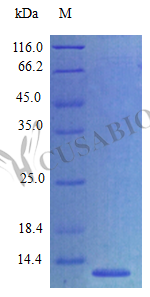Recombinant Mouse C-C motif chemokine 27 protein (Ccl27) is produced in E. coli and represents the full length of the mature protein, spanning amino acids 26 to 120. This product comes without tags, which should minimize interference in experimental work. The protein appears to have a purity of over 98% based on SDS-PAGE analysis. It shows full biological activity, with activity confirmed through a chemotaxis bioassay using human peripheral blood lymphocytes at concentrations between 10-100 ng/ml. Endotoxin levels stay below 1.0 EU/µg, as measured by the LAL method.
C-C motif chemokine 27, also known as Ccl27, seems to play an important role in immune responses, mainly by directing cell movement through chemotaxis. This protein appears to help recruit specific immune cells to inflamed areas, contributing to the body's defense systems. Ccl27 may be particularly valuable for studies examining immune signaling pathways and inflammation, potentially offering insights into how cells communicate and respond in different research settings.
Potential Applications
Note: The applications listed below are based on what we know about this protein's biological functions, published research, and experience from experts in the field. However, we haven't fully tested all of these applications ourselves yet. We'd recommend running some preliminary tests first to make sure they work for your specific research goals.
1. Chemotaxis Assay Development and Optimization
This recombinant mouse Ccl27 protein is confirmed to be biologically active in human peripheral blood lymphocyte chemotaxis (active at 10-100 ng/ml) and suitable as a positive control. However, researchers should validate its activity in mouse-specific lymphocyte populations to confirm that cross-species reactivity is consistent. The high purity (>98%) supports reliable dose-response studies, but optimal concentrations may need adjustment for primary mouse lymphocytes due to potential species-specific receptor affinity differences.
2. Receptor Binding and Interaction Studies
The biologically active Ccl27 is appropriate for CCR10 receptor binding studies, but the demonstrated activity in human cells suggests cross-species reactivity that may not fully represent mouse-specific binding characteristics. Researchers should validate binding kinetics in both human and mouse receptor systems to properly interpret species-specific differences in affinity and specificity.
3. Antibody Development and Validation
This high-purity Ccl27 serves as a good immunogen for antibody development. The confirmed cross-species bioactivity indicates proper folding of conformational epitopes. However, antibodies should be validated against native mouse Ccl27 from biological sources to ensure recognition of physiologically relevant forms, as the E. coli expression lacks mammalian post-translational modifications.
4. Structure-Function Relationship Studies
The full-length mature protein (26-120aa) is suitable for structure-function studies, but researchers should note that the E. coli expression system lacks the glycosylation present in native Ccl27. Mutagenesis studies should account for potential differences in protein behavior compared to glycosylated forms found in physiological conditions.
5. Cell Culture Medium Supplementation for Migration Studies
This Ccl27 can be used to create chemotactic gradients, but the cross-species activity data requires validation in mouse-specific systems. Researchers should establish dose-response relationships in mouse lymphocyte cultures to ensure physiological relevance, as human lymphocyte responses may not directly translate to mouse cells.
Final Recommendation & Action Plan
This recombinant mouse Ccl27 protein is a validated reagent with demonstrated cross-species bioactivity, making it suitable for the proposed applications with appropriate validation steps. First, establish mouse-specific activity profiles using primary mouse lymphocytes to complement the existing human cell data. For chemotaxis studies, use the 10-100 ng/ml range as a starting point, but optimize for each specific cell type. When developing antibodies, validate cross-reactivity with native mouse Ccl27 from skin or other relevant tissues where Ccl27 is naturally expressed. For binding studies, the confirmed bioactivity supports CCR10 interactions, but researchers should determine species-specific binding parameters separately. While the E. coli expression produces a non-glycosylated protein, the demonstrated bioactivity confirms proper folding for receptor engagement. Always include proper controls and consider that different lymphocyte subsets may exhibit varying sensitivity to Ccl27 stimulation. The high purity and low endotoxin make this protein particularly valuable for controlled studies of skin-homing lymphocyte responses across species.




